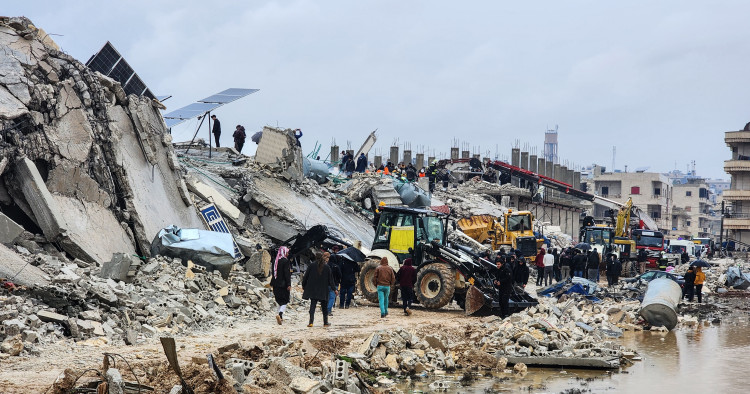At 4:17 AM, southern Turkey and northern Syria were struck by a crippling 7.8 magnitude earthquake. Twelve hours later, at least 2,400 people are known to have perished, with death tolls rapidly rising. This natural disaster could not have come at a worse time or struck a more vulnerable region — with notoriously poor construction in southern Turkey and the effects of more than a decade of brutal conflict still afflicting northern Syria. As people slept, buildings collapsed — at least 3,450 in Turkey and many hundreds if not thousands more in Syria.
The destruction in Turkey is being described by authorities as befitting a warzone. At the same time, the impact meted out on the Syrian side of the border, by the earthquake and an equally powerful aftershock hours later, has been catastrophic. For northwestern Syria, this earthquake represents an emergency within an emergency — and a crisis within a crisis. The region was already home to the world’s most acute humanitarian crisis, with nearly 3 million internally displaced people (IDP), almost all of whom are entirely dependent on foreign aid. After 12 years of brutal shelling by the Syrian regime, at least 65% of the area’s basic infrastructure was already destroyed or heavily damaged, and the medical and rescue worker sectors have faced years of targeted regime attacks.
According to contacts on the ground, every village, town and city district has suffered mass destruction. Thousands of civilians are thought to be trapped under rubble — many of whom can be audibly heard screaming for help. Rescue workers, opposition fighters and civilians are all desperately seeking to help. Every major hospital or medical clinic has reached capacity, with patients being treated on floors, in hallways and outside in the winter cold. In one town alone, in al-Atareb in Aleppo’s western countryside, nearly 100 dead bodies have been recovered.
Prior to the earthquake, northwestern Syria’s IDP camps were already far beyond capacity, but the scale of destruction caused overnight will inevitably see those camps swell. This will require a substantial ramping up of the United Nation’s emergency humanitarian aid mission, with an emphasis on shelter, food, and crisis healthcare. In the midst of a harsh winter, combined with Syria’s precipitous economic collapse and severe fuel shortage, it is hard to imagine a region more vulnerable and less well positioned to deal with such a natural disaster.
While the international community mobilizes to assist Turkey’s disaster needs, the ability to do so for northern Syria’s most vulnerable is highly complex. After years of Russian vetoes and both military and diplomatic pressure, the U.N.’s aid mission in the region is restricted to just one border crossing from Turkey. Moreover, that U.N. effort is designed for humanitarian assistance — not disaster relief and emergency rescue. Already, some activities along the border have been hampered by the earthquake, with a long-standing arrangement between Turkey and Syrian opposition authorities to evacuate emergency medical cases to Turkish hospitals coming to an abrupt stop overnight. Syria’s famed White Helmets, staffed by 3,000 volunteers, have deployed in full, but they are reportedly running out of diesel to operate their heavy equipment. U.N. aid facilities on the Turkish border were also hit and damaged by the earthquake.
It is unclear how precisely a major international disaster relief effort can take shape in northwestern Syria; however, only a concerted and immediate push by the United States and allies will make anything feasible. Making use of the existing U.N. aid mission and Turkish facilitation would allow a platform upon which to build, but the scale of the needed response is huge. Syria’s people have been abandoned and forgotten too many times and for too long — we cannot leave them alone again.
Charles Lister is a senior fellow and the Director of the Syria and Countering Terrorism & Extremism programs at the Middle East Institute.
Photo by Zana Halil/ dia images via Getty Images
The Middle East Institute (MEI) is an independent, non-partisan, non-for-profit, educational organization. It does not engage in advocacy and its scholars’ opinions are their own. MEI welcomes financial donations, but retains sole editorial control over its work and its publications reflect only the authors’ views. For a listing of MEI donors, please click here.













